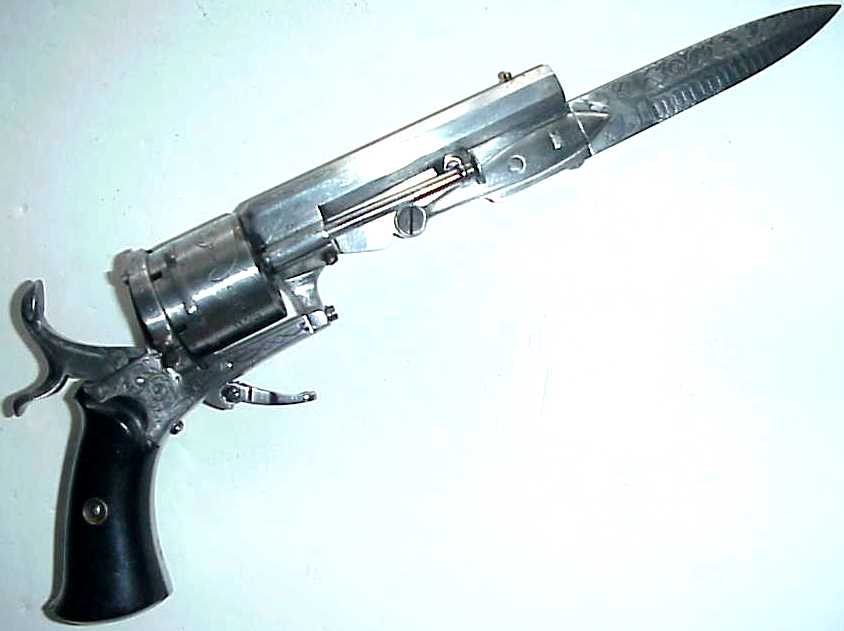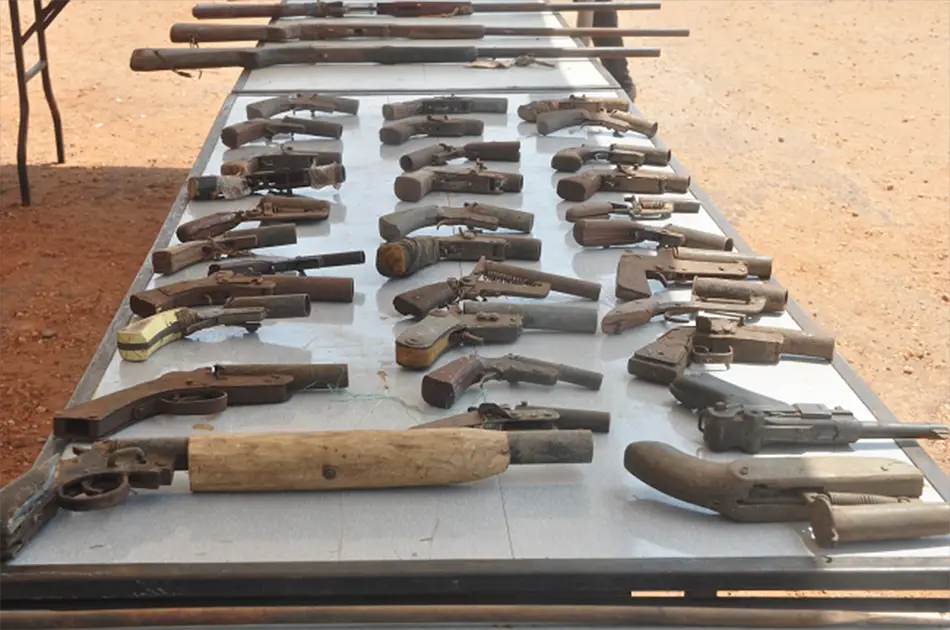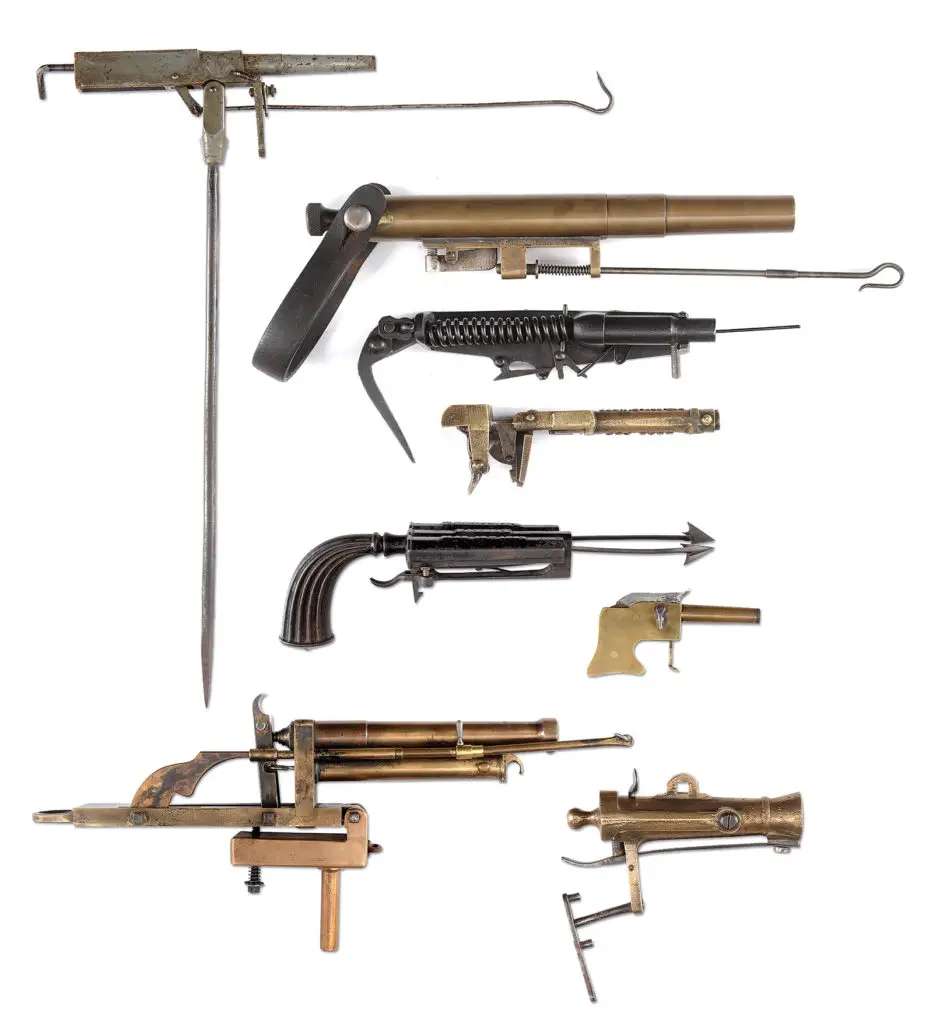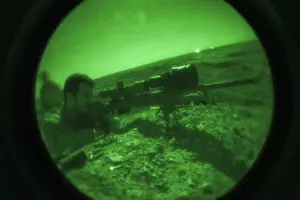Category Archives: Unconventional Weapons
 Why would we make a single dealer the Wednesday Weapons Website of the Week? Well, Horst Held is not just any dealer. Not when you take into consideration the historic significance and quality of the collector pieces Horst is selling. Even if some of them are priced in the nosebleed range, his collection is broad enough, deep enough, historic enough, and packed enough with odd curiosities — like the flintlock revolver currently on the front page — to be an education in itself.
Why would we make a single dealer the Wednesday Weapons Website of the Week? Well, Horst Held is not just any dealer. Not when you take into consideration the historic significance and quality of the collector pieces Horst is selling. Even if some of them are priced in the nosebleed range, his collection is broad enough, deep enough, historic enough, and packed enough with odd curiosities — like the flintlock revolver currently on the front page — to be an education in itself.
We first came across his site while trying to decode the mysteries of the repeating pistols of Weipert (Vejprty), Bohemia. For example, he has two Gustav Bittners in stock. Given the prices he has placed on them, all we can do is look, but he has characteristically included numerous photographs of these peculiar and historic “missing links” between the first single-shot and double-barrel cartridge pistols, and the true semi-automatic service pistol which came along in a few years and rendered the repeaters, operated lever-action (usually by action of the trigger guard), obsolete.
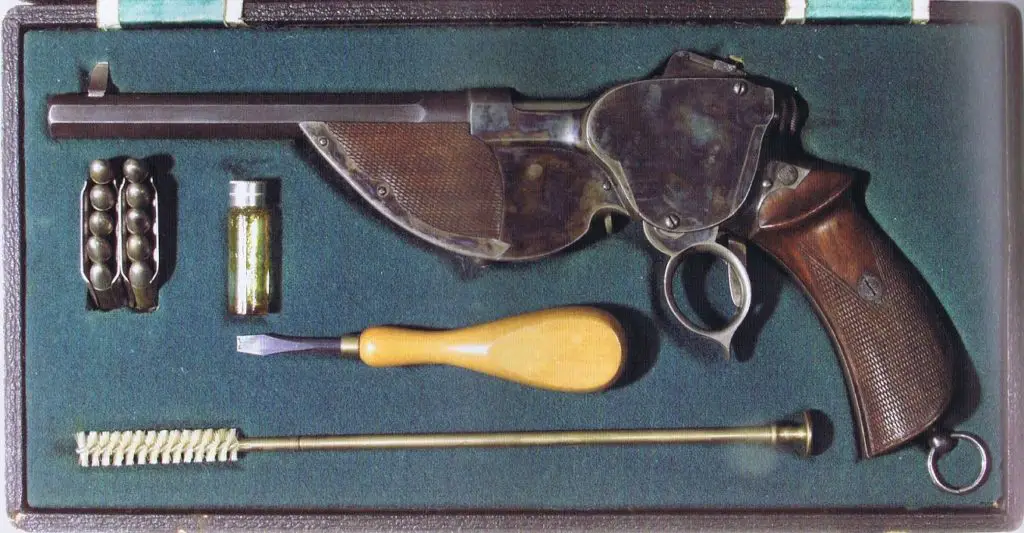
Bittner Repeating Pistol, (7.7mm?) cased with tools, ammo and en-bloc clips, from Forgotten Weapons. We believe this pistol to be in the personal collection of Horst Held.
He also has a page on those strange hybrid weapons that incorporate a pistol or revolver and some kind of knife or sword blade, with an awful lot of examples, not including the rare Elgin Sword Pistol. The Elgin may be rare in absolute terms, but it’s common compared to his examples, like this Dumonthier revolver with a folding bayonet!
And then there’s a Dreyse needle-fire — but it’s not the celebrated Prussian rifle of 1870, but a double-action needle-fire revolver.
But there’s far more here than just that. If you can look at this site and not learn anything, we’ll be very surprised — “By the heathen gods that made ye, you’re a better man than I am, Gunga Din.”
And if you look at the site, you’ll almost certainly be entertained. You may not want to spend thousands on exotic antiques, but you’ll marvel at the ingenuity that went into some of these artistic creations, even as you wonder at the thought processes of the designer who thought it might be practical.
Comparing Nuclear “Deals”: South Africa and Iran
The Foreign Policy Institute has an interesting, brief comparison of the Iran deal, which they opposed, with the nuclear disarmament of South Africa.
They point out that the President said this, announcing the Iran deal:
An unprecedented inspections regime.
The most comprehensive and intrusive inspection and verification regime ever negotiated.
The most vigorous inspection and verification regime by far that has ever been negotiated.
Pretty much every word of that was a lie. There is, essentially, no independent inspection; there is no verification; there is instead a date certain that erases even the fiction of inspection. Iran, of all nations, has been put on the honor system, as if “honor” means anything to mohammedan savages, anything but a handy excuse to murder your daughter or sister.
The contrast they use depends on a fantastic report, Revisiting South Africa’s Nuclear Weapons Program, that does a thorough analysis of the rise and fall of this historically unique program — the only time in history that a nuclear power unilaterally disarmed. The document is here with links to free .pdfs. FPI describes it thusly:
Revisiting South Africa’s Nuclear Weapons Program provides a detailed account of the development of South Africa’s nuclear program, from its embryonic stages, in the 1950s, as a nuclear research and development center to its eventual production, beginning in the late 1970s, of six nuclear warheads. According to the authors, Pretoria, in the program’s early years, likely wished only to acquire the option to develop nuclear weapons but harbored no desire to operationalize this capability. Ultimately, however, the apartheid regime altered its strategy largely in response to rising fears of Soviet expansionism, hoping that the mere possession of the warheads — rather than their actual use — would deter aggression.
It’s actually quite a good study of a little-known armament program.
FPI then contrasts South African open disarmament with Iran’s mockery of international engagement, whilst maintaining a clandestine nuclear arms and delivery systems (the ballistic missiles are a key nuclear technology, after all) program.
The essential difference, however, seems to have been missed by FPI’s Tzvi Kahn. The RSA, unlike the Islamic Republic of Iran, wanted to disarm. (It’s also a fact that they didn’t want to leave a nuclear capability in the hands of a nation that has potential to give rise to a Mugabe or Amin). The Iranians are not the least interested in disarming. It sounds like madness, but their cult preaches to them that they will rule the world, and they mean to do just that. Nuclear weapons are a means to that end. Iran has no interest in disarming, and must be disarmed by force or economic pressure — neither of which is palatable to an administration more attuned to Iran’s aspirations and interests than to America’s.
Terrorism: Economy of Force
 One of the consequences of our contretemps with the Russians is that we’re experiencing a Great Relearning of things they learned in long conflict with Chechen and other Islamists. One of them is this: attacking terrorist funding and logistics only goes so far, because compared to national armies or security services, terrorism runs on a shoestring budget. It is by its very nature an economy of force operation.
One of the consequences of our contretemps with the Russians is that we’re experiencing a Great Relearning of things they learned in long conflict with Chechen and other Islamists. One of them is this: attacking terrorist funding and logistics only goes so far, because compared to national armies or security services, terrorism runs on a shoestring budget. It is by its very nature an economy of force operation.
Recent analysis of high-profile terror attacks inspired by ISIL in France bears this out. We have edited the excerpt below: we have inserted values in $USD based on today’s rounded exchange rate ($1.22=£1), further rounded to the nearest $500 or so.
The string of attacks in France, which have killed more than 200 people in less than two years, were funded by jihadis selling cheap ‘made in China’ clothes and accessories on the black market, as well as insecure consumer loans.
Researchers at the Centre for the Analysis of Terrorism in Paris combed the bank accounts of bloodthirsty jihadis behind the Charlie Hebdo, Bataclan and Nice attacks.
The perpetrators of the January 2015 attacks, which targeted Charlie Hebdo and a Jewish supermarket – Amedy Coulibaly and brothers Chérif and Saïd Kouachi – spent a combined total of £23,000 ($28,000).
More than £18,000 ($23,000) was used to buy a range of heavy weapons, including two sub-machine guns and two semi-automatic pistols, and a rocket launcher.
Heavy weapons? Well, it’s an English paper. If they looked in many of our readers’ gun rooms or safes, they’d go up like Guy Fawkes. FOOM!
Between them, Coulibaly and the Kouachi brothers killed 17 people: 12 people were killed in the attack on the Charlie Hebdo newsroom, and four people were killed in the attack on a Jewish supermarket. A female police officer was also shot dead by Mr Coulibaly.
The November 13 Paris attacks – when shootings at the Bataclan theatre and bomb blasts left 130 people dead and hundreds more wounded – were the most “expensive and complex” said the CAT researchers, and cost the radical Islamists a total of £73,000 ($89,000).
According to French weekly le Journal du Dimanche, where the study was published, ISIS chiefs gave each terrorist £2,600 ($3,000) to spend on the attacks – the rest they paid for themselves.
Two of the attackers, brothers Salah and Brahim Abdeslam, ran a bar in Molenbeek, Belgium, and took money directly from the till.
Hasna Aitboulahcen, the cousin of Abdelhamid Abaaoud, the ringleader behind the Paris massacre, gave the terrorists £3,500 ($4,500) before blowing herself up.
The extremists spent £24,000 ($30,000) on travel, £17,000 ($21,000) on secret hideouts, and £14,000 ($17,000) on suicide vests and guns, including six AK-47 rifles.
In addition, the ISIS executioners spent £10,000 ($12,000) on rental cars, and £7,000 ($8,500) on phones and fake ID.
The Nice attack, which took place on July 14 whilst crowds were busy celebrating Bastille Day, the French ‘Independence Day’, was the least expensive, and cost ISIS fanatic Mohamed Lahouaiej-Bouhlel no more than £2,200 ($2,500).
Mr Lahouaiej-Bouhlel, who has been described as a “sex-obsessed, pork-eating alcoholic”, used the money to buy a gun and to rent the 19-tonne lorry he used to plough through the Bastille Day crowds. The ISIS convert killed 86 people during the attack, including 30 Muslims.
CAT researchers also said that suspected terrorists’ bank accounts should be checked on a regular basis, as keeping an eye on their financial transactions could help prevent future attacks.
via How European ISIS terror attacks cost just £2,000 | World | News | Daily Express.
You should be reassured that, while the Diverse Vibrancy coming to a refugee shelter near you could very well kill you, at least they won’t be profligate spendthrifts whilst doing you, and they will dispatch you in a practical, economical manner.
The linked article says that surveillance of the suspected jihadis’ bank accounts might help to expose them — a few paragraphs where it describes how several of them scammed the necessary money off of cash businesses and thefts. That’s what passes for deep thinking in Journalistan.
Jamming their money up, or watching their money, is not going to be effective when they need very little money. It’s reminiscent of the great extremes and risks our special operations forces and airmen took to bust trucks on the Ho Chi Minh trail, when the while North Vietnamese combat effort in South Vietnam needed only 4,000 to 6,000 pounds of supplies of all classes daily. It sounds like a lot, but consider this: you not only had to bust trucks, you basically had to bust all of them, because the enemy ran his whole war on less than 2-3 trucks a day. But MacNamara never thought that one all the way through. (Show us your shocked face, on a screwup by Mac?)
An Overview of US Defense Posture, 2016.
 The problem with many official pronouncements that emanate from the E-Ring is credibility. Most of the denizens of that Ring are so ate-up with policy and partisanship, that even when they refrain from slanting their output to fit the party line, the knob-polishers and horse-holders who grovel ambitiously around the penumbrae of their campfires have slanted their inputs so as to please them.
The problem with many official pronouncements that emanate from the E-Ring is credibility. Most of the denizens of that Ring are so ate-up with policy and partisanship, that even when they refrain from slanting their output to fit the party line, the knob-polishers and horse-holders who grovel ambitiously around the penumbrae of their campfires have slanted their inputs so as to please them.
In other words, one of the hardest things, when you’re Boss (or close to it), is getting the Regular Joes and Janes to tell you unvarnished truth, and not what they think you want to hear.
So that is some background to the word we got from a friend currently performing a period of penance in the Pentagon for his sins as a senior special operations officer. The word is that Pentagon planners are increasingly referring to outside documents to get a handle on what’s really happening in Defense. One document that came up is the Heritage Foudation’s frank and scathing 2016 Index of US Military Strength: Assessing America’s Ability to Provide for the Common Defense, available here. (Big .pdf). We’ve actually discussed this document before (or perhaps the 2015 version), but it’s worth looking at again.
The document focuses on the three regions where threats to vital US interests have arisen or can arise: Europe, the Middle East, and Asia. It weighs US military power by yardsticks of capability, capacity, and readiness.
The conclusions are sobering:
…little has been done to arrest the decline in our nation’s physical ability to confront … challenges. (p.xiii).
America’s “hard power” has deteriorated still further over the past year, primarily as a result of inadequate funding that has led to a shrinking force that possesses aging equipment and modest levels of readiness for combat. (ibid).
America’s continuing decline in military hard power is thoroughly documented and quanti ed in this report. (p.1).
In aggregate, the United States’ military pos- ture is rated as “Marginal” and is trending toward “Weak.” (p. 12).
Essential maintenance continues to be deferred; fewer units (mostly the Navy’s platforms and the Special Operations Forces community) are being cycled through operational deployments more often and for longer periods; and old equipment is being extended while programmed replacements are problematic. (ibid).
[USAF] “readiness” dropped from “strong” to “marginal.” Although difficult to categorize, the readiness decline is best attributed to reports that under half of the service’s combat air forces meet full-spectrum readiness requirements. (p.13).
…our comparative military advantage is starting to wane, but even as American military power declines, the demands made on the military are increasing. (p.46).
The decline in the size of the active-duty force caused by reduced budgets has sparked tension among the Active, Guard, and Reserve components over their respective missions and corresponding resources. (p.61).
Many NATO Countries spend less on defense than the New York Police Department. (p.81).
One of the key weaknesses and most mismanaged areas of defense over the last two administrations has been the nuclear balance. If it continues to deteriorate, it will probably be impossible to prevent former US allies and nuclear dependents from going their own way with their own independent deterrents.
 The reasons we’ve had two administrations’ worth of nuclear decline are varied, but certainly the largest factors are the last administration’s focus on counter-goatherd operations, on the one hand, and the present administration’s quixotic pursuit of unilateral nuclear deterrent and “peace” at any price. You could say that the former results from short-term thinking and lack of a horizon focus, and the latter results from sheer childish naivety.
The reasons we’ve had two administrations’ worth of nuclear decline are varied, but certainly the largest factors are the last administration’s focus on counter-goatherd operations, on the one hand, and the present administration’s quixotic pursuit of unilateral nuclear deterrent and “peace” at any price. You could say that the former results from short-term thinking and lack of a horizon focus, and the latter results from sheer childish naivety.
The same naivety that thinks that our nukes are destabilizing tends to be comorbid with belief in other kinds of magical thinking, like Gun Free Zones. It’s not a partisan political problem, this magical cognitive fuzz: does anyone remember the No Child Left Behind Act, which solemnly explained how, over time, all children would be elevated to be Above Average?
Say what you will about education, but basic numeracy seems absent inside the Beltway and along the Acela Corridor.
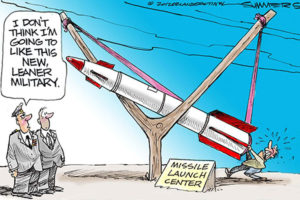
Actually, the cartoon misses the teamwork in the new, Diversity-Forward Military. Instead of one stout guy, the missile must be launched by a 90-lb. woman, a dwarf, and a pygmy.
One of the most disturbing parts of the document is the appendix that lists major systems and their scheduled replacements — if any. For example, the Navy has no replacements in mind for its cruisers, just a low-low mix of destroyers and defenseless, offenseless, “presence” LCSes. The submarine force is subject to massive cuts by attrition. In every defense regime, manpower, units and both quantities and kinds of forces are being cut without respect to requirements.
Eliminating variety of forces is the kind of thing that looks good to managerial types who want to apply MBA quantitative figuring to readiness. The problem is that this simplifies the enemy’s task in developing countermeasures for your forces. You not only need a certain level of capability, you need enough variety in your capability to be unpredictable to the enemy. This is very hard to get across to a zero-time-under-rucksack “Defense Intellectual” with a green eyeshade, who has risen to sit in the Aeron chair of command critic.
The next edition is due sometime next month, November 2016, and the word inside the Ring is that it will describe an even bleaker situation.
One of these Guns is Not Like the Others
Sing along with us, kids:
One of these guns is not like the others;
One of these guns just doesn’t belong.
Can you guess which gun is not like the others,
Before I finish my song?
(Puzzled international readers, that’s from a long-running and hell-for-saccharine TV kids’ “educational” show which everybody’s mother made him watch at least a few times). Now that we’ve had our sing-along, here’s the photo. Which one doesn’t belong?
The photo ran a couple months ago in the always entertaining Impro Guns website, with this heading:
Locally produced firearms seized in Ghana
And all of the pistol-things on the table are, indeed, the sort of thing you’d expect from Ghanaian village blacksmiths — except the Luger P.08 that’s the second one back on the right.
Wonder what its story is? Unfortunately, some Ghanaian copper has probably already either thrown it into a smelter, or sold it back onto the black market.
The constant panoply of odd creations that turn up on Impro Guns illustrate many things, but one of the major ones is, “What a simple machine a gun is to build,” and another, “How universal the desire for firearms is,” Most of these improvised guns are made where strict gun control reigns, or tries to. A great many of them are made by criminals and terrorists. Others, however, seem to be the product of hobbyists, and still others, made by or for people who simply feel a need for self-defense, a need that is never met perfectly by The State.
Indeed, in most strict gun control jurisdictions, the state makes nearly no effort to step in and defend its disarmed populace. Look at LA or Chicago, with hundreds and thousands of murders respectively, most of which go unsolved even though none of them seem to be committed by criminal masterminds. So at some point, the peaceable and formerly law-abiding person breaks out and builds himself, or has built for himself, a tool of self defense.
The criminal element, meanwhile, skips simple defensive handguns and long guns, and goes right to making suppressed automatic weapons, as the police in Australia have discovered. The Australian gun ban (semi-autos and pump and lever shotguns) has not seriously inconvenienced the criminal element, which is well armed with auto weapons on the conceptual level of the Sten or Mac-10. Criminals used to avoid these weapons because of the disparity in consequences for getting caught with one, vis-a-vis a revolver. Now, a criminal is as well hung for a sheep as a lamb, and goes direct to St. Valentine’s Massacre capability.
The only consequences you can always count on are unintended consequences.
Note: we’re still running late here, over 12 hours behind schedule, for which we beg your forbearance. Your Humble Blogger has been a bit under the weather, and dealing with it by drinking plenty of fluids, skipping PT (unfortunately) and spending plenty of time snoring in the recliner with Small Dog Mk II. These are wondrous and joyful activities indeed, but they don’t get the blog written on schedule. Bear with us — Ed.
We’d Have Called it the Drone Dropper… or Drone-B-Gon
This anti-drone device is going viral. They’ve clickbaited it well by calling it the Skynet anti-drone rifle, and it can directionally jam the GPS signals a drone needs to navigate, and the wireless video downlink.
 The two white and black “barrels” are directional antennae in two separate GHz ranges. The backpack is the necessary power source. Anyone who’s got Electronic Warfare experience will tell you jamming is a power-intensive activity.
The two white and black “barrels” are directional antennae in two separate GHz ranges. The backpack is the necessary power source. Anyone who’s got Electronic Warfare experience will tell you jamming is a power-intensive activity.
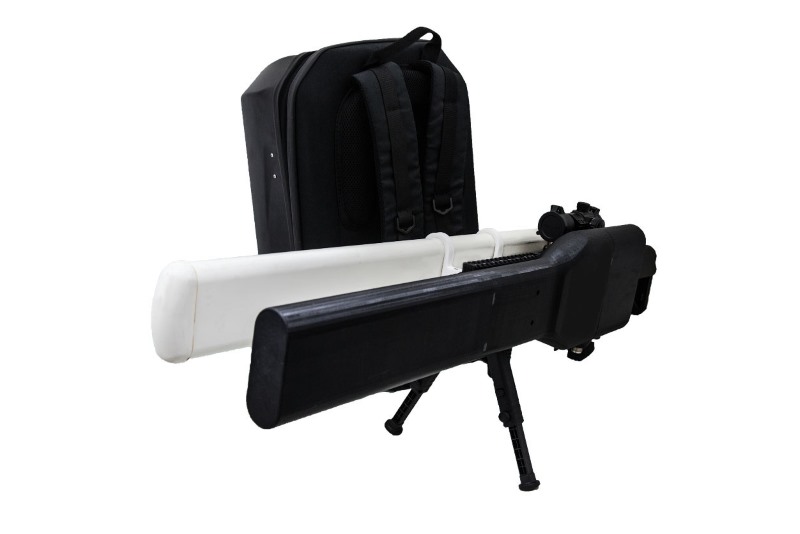 If you look at all the pictures available on the company’s website, and watch the video (below), the whole thing appears to be built on a (partial? modified?) AR-15 receiver, with a standard M4 receiver extension and stock. A bit overkill for just something to hang an arduino, a transmitter, and some highly directional (< 10º) antennae on, but it kind of makes sense to give people a familiar interface, and the AR-15 is the point and click interface for the 21st Century.
If you look at all the pictures available on the company’s website, and watch the video (below), the whole thing appears to be built on a (partial? modified?) AR-15 receiver, with a standard M4 receiver extension and stock. A bit overkill for just something to hang an arduino, a transmitter, and some highly directional (< 10º) antennae on, but it kind of makes sense to give people a familiar interface, and the AR-15 is the point and click interface for the 21st Century.
Along with this video, there’s a new one showing a live test. They claim a “suppression ratio” (difference between the range from the Skynet operator to the drone and the drone controller to the drone) of 8:1, which means (thinking of power squares here) that this jammer has vastly more power than the controller.
The two signal rangess it can jam are 1.450 GHz – 1.650 GHz and 2.380 GHz – 2.483 GHz, but it can only jam one at a time. Available hacks for, for example, the DJI Phantom drone (the one in the video) can take the drone control out of the target range, and could practically be developed for the video range.
There are a few other problems with it, to wit:
- As a jammer, it is almost certainly illegal to use in the USA. The Federal Communications Commission takes a dim view of jamming, and has considerable technical and legal resources it deploys to punish violators.
- It’s only effective against some common commercial drones and is unlikely to have any impact on a more sophisticated government or military system, which is likely to use robust, high-availability communications, and have backup onboard navigation (usually inertial) that’s immune to jamming or meaconing.
- It requires clear line-of-sight to the drone, ergo, it’s only useful as a point-defense weapon.
- It requires a human operator and visibility of the target. (How would it work in the dark, against a drone deploying LLLTV? We suppose there’s a Picatinny rail upon which you can mount an image intensifier or thermal sight).
- It has the scent of early prototype all over it, and is a long way from a commercial product or (alternatively) a flexible R&D platform. But even experimenting with this thing brings you back around into the sights of the FCC.
Finally, this is, we think, the firm’s first video, from May.
All in all, it smells to us like a gimmick. And within the range of this thing, there are other ways to take out a drone (one lady pestered by paparazzi drones seeking spy shots of a celebrity neighbor demonstrated her wingshooting skills and blew the drone to Kingdom Come. The paparazzi boarded their Range Rover — apparently invading privacy pays well — and were last seen heading back for Gawker HQ or whatever glutinous sump whence they emerged).
This is not the only anti-drone product out there. As well as other jammers, there are counter-drone drones that ram them or drop nets or cables onto their rotors. All of them are similarly immature at present, and no one knows if they represent a real market segment or just hobbyists tinkering.
One Man’s Trap is Another Man’s Treasure
This image, which does embiggen, shows a variety of trap guns that are among the many treasures in James D. Julia’s October Auction. Trap guns (which are also called “spring guns,” and other names) were common means of poacher and burglar control from the fifteenth through the 19th centuries. Basically, it’s a firearm arranged to be set up unattended and fired by a tripwire. Such a booby trap could easily be rigged with any firearm and a basic understanding of pulleys, of course, but purpose-made trap guns were cheap and low-maintenance.
A 1983 American Society of Arms Collectors article[.pdf] by Melvin Flanagan runs through some of the historic trap guns and helps make a tentative identification of some of these… at least, that is, until Julia publishes a final catalog. Numbered from top to bottom:
- Sure-Shot trap gun, in which the same tripwire swung the gun on target and then fired it. Designed by Charles D. Lovelace and made in several varieties by several firms from 1913;
- Unknown;
- W. Cameron trap gun, patented 1891;
- Unknown;
- Reuthe Trap Gun, fourth model. Frederick Reuthe earned the first US patent for a trap gun in 1857;
- Unknown;
- A probable 20th-Century fake, probably made in the vicinity of Omaha, Nebraska;
- Unknown.
Trap guns were used by the British Army to secure armories during the Colonial gunpowder-raids period in 1773-1775, and, according to Colonial Williamsburg’s history of the powder magazine, was instrumental in the initial overthrow of King George III’s governor in Virginia, Governor Lord John Murray, the 4th Earl of Dunmore (a Scots title). Dunmore had been a career soldier, and later Governor of New York before being named to the wealthier Southern colony. He was a gun-control believer, and sought to confiscate, disable (for instance, by having the locks of the militia’s muskets removed), and to the extent possible, spirit away onto HM’s ships, the arms and ammunition that might feed a rebellion. He set stringent security measures on the magazine at Williamsburg. But on the night of 3-4 June, 1775, a spring gun that was one of those security measures set history in motion:
[A] spring-gun trap set at the Magazine wounded two young men who had broken in. A furious mob stormed the building June 5. Rumors that the royal marines were returning brought out the militia. June 8, Dunmore fled to H.M.S. Fowey. British rule in Virginia was at an end.

SM-70 illustration as a poster: “Wanted: Visit East Germany. The World’s Last Headhunter Reservation.” (Thanks to an anonymous reader for the correction — Ed.)
Trap guns have little military application, except as generic booby traps by unlawful combatants. They were used, along with several types of antipersonnel mines, along the inter-German border by the quisling regime in East Germany. Some East German trap guns were converted cartridge-firing firearms, but from 1970 a special purpose directional mine called the Splittermine Modell 1970 was set up at intervals to booby-trap the expanded-metal fence that was one of the many security layers of the Berlin Wall.
Trap guns gradually fell out of favor, especially after World War II as courts came around to the idea that criminals’ rights were more important than victims’. In the USA, the key rulings were Katko v. Briney (1971) and McComb v. Connaghan (1990) in which career criminals (Katko and McComb) were held to be unlawfully killed. At least one other booby-trap dead burglar case was resolved with the acquittal of the booby-trapper, but he used electricity, not a trap gun.
Despite these rulings, trap guns and booby-traps are not banned, per se, in many jurisdictions. But it’s hard to imagine a situation in which an attorney would advise a property owner to deploy such devices. They’re a use of deadly force that is not being used to protect life and limb; they seem to fail several prongs of the use of deadly force test.
Consequently, the trap gun is an artifact of a lost period in history, and a collector’s item… some of which are coming available at auction.
How Anti-Soldier Lawyers Banned a Kind of Ambush
Two men from the IED cell padded silently down the road. Abdul and Roshanullah had two 107mm rocket warheads, a cell-phone detonator, and detailed instructions, including a sketch map of their emplacement point. The rest of their cell waited for them to return.
At a point where the road crossed a filled area, the two HIG men — many Afghans changed allegiances more frequently than their shalwar kameez, but once you were Gulbuddin Hekmatayar’s man, you were always Gulbuddin’s man — slipped down the side of the fill to the mouth of the culvert. This one hadn’t been fitted with a grating yet, but even if it had, they had been prepared.
There was just enough starlight for Abdul to see Roshan’s grin. This was going to be easy! First, the blessing: “Bismillah al-Rahman al-Raheem,” In the Name of God, the Gracious, the Merciful…
High on a hill facing the culvert, nearly half a mile away, a sniper team leader whispered, “Send ’em.”
The wind was fortuitously towards the hill, and at the culvert, all that there was to hear was the thwack of bullet impacts. Then one of the men — Roshanullah, not grinning any more — groaned and moved.
Thwack.
All was still.
An hour before sunrise it was visibly getting light in the valley, and the five armed men who came down the road moved from cover to cover, nervously. They were breaking every tactical rule that had kept them alive this long, but their leader wanted to lay his own eyes and hands on the IED team.
They all died within the span of one and a half seconds. With five targets, both snipers, the spotters, and the team leader had all taken one. That was breaking a tactical rule too, but the difference was, the rulebreaking worked for the ISAF snipers. They recovered their 360º observation as soon as the shots were sent, also.
The team met the road clearance unit for a ride into the FOB. Intelligence collected from the dead laid bare the workings of the cell, and the telephone carried by the deceased IED cell leader allowed the Afghan NDS to identify two key HIG facilitators; one fled to Peshawar and the protection of ISI, but the other was reputed to be singing like a canary.
It was a successful operation until the Staff Judge Advocate spoke up, taking, as usual, the side of the enemy, and demanded the snipers be charged with war crimes — for shooting armed unlawful combatants carrying out combat operations!
Believe it or not, Army lawyers have defined this tactic as a “baited ambush” and have worked hard, if not to make it a “war crime,” at least to create a grey area in which it is the slightly less felonious “violation of the laws of war” and possibly a “war crime.” Lawyers, of course, love grey areas which take decisions out of the hands of decision-makers and deliver them, instead, to the captivity of cabals of, what else, lawyers.
For example, Army judge advocate LTC Chris Jenks — clearly, from his writing, the sort of SJA who joined the Army for personal gain, hostile to the guys with guns who make up the actual Army part of the Army — wrote in The Army Lawyer1 that this tactic “comes close to, if not enters, the law of war violation continuum….”2
Certainly this is an example of why it is impossible to win a war without first staking out the enemy’s fifth columnists, to wit, about 95% of SJAs, on culverts like the ones in our hypothetical, and letting the enemy have their way with them.
Jenks also doesn’t think the troops should enjoy a victory:
Members of the unit filmed the artillery strike and can be heard laughing and cheering, which presents additional challenges to a command.3
One gets the impression that his spectator sport is golf or tennis, not football or hockey. And he grew up in the age of scoreless soccer, and participation trophies.
Jenks makes a few clumsy gropes in the direction of understanding military necessity, a concept he, not surprisingly, has not picked up by osmosis merely by donning a bestowed uniform bearing an unearned rank. But he still concludes that hunting over bait is outside of the fish and game regulations of scoreless-soccer SJA war:
Ultimately, in the absence of an armistice or suspension of fire, engaging combatants attempting to recover their dead and wounded is not a per se violation of the law of war, but utilizing known—or even suspected—enemy wounded and dead as “bait” for such targeting enters the continuum and, at some point, will constitute a violation of article 15.
(The reference is to Article 15 of the First Geneva Convention of 1949). Jenks continues:
The more time that passes following the engagement, the closer the engagement is to U.S. forces, and the more control U.S. forces have over the “field of battle,” the more likely the failure to search for enemy wounded and dead becomes to violating the Geneva Convention.4
We bet we can guess what Scoreless Chris Jenks thinks about whether pirates should be held hostis humanae generis or treated with kid gloves in Article 3 courts, just based on the way he reasons himself into coming down on the side of our hypothetical decedents Abdul and Roshanullah here.
Army lawyers are entertaining, if you don’t have to operate like Combat Houdini, kicking off every patrol with their manacles and straitjacket on you.
Sources
Jenks, Chris “LTC”. The Law and Policy Implications of “Baited Ambushes” Utilizing Enemy Dead and Wounded. The Army Lawyer, June 2010. DA PAM 27-50-445. pp. 91-94.
Notes
- The Army Lawyer is a monthly magazine in which the judge advocate fifth column coordinates their attacks on combat troops.
- Jenks, p. 91 fn 1.
- Ibid.
- Jenks, p. 93.
Banned in Boston: Death Rays and Phasers
We are not making this up. The State of Massachusetts, ground zero for the world hoplophobia movement, has banned any “weapon from which an electrical current, impulse, wave or beam is designed to incapacitate temporarily, injure or kill.” That’s clearly a ban on death rays and phasers, just in case they might be invented! It would also seem to cut off any possibility of some citizen militia arming up with photon torpedoes and phased pulse rifles in the 40 megawatt range. Men of Northeast Shooters Forum, you have been warned: govern yourselves accordingly.
Invent a working example of any of these, and you get 2½ years in the State House of Correction, with all the pervos and hardened prestoopniks (like two of the last three heads of the State Senate, for instance).
Now, while the wise legislators (heh) of the Massachusetts General Court have ensured that the rabble in such dodgy places as Lexington and Concord aren’t amassing pulse cannons and storing hogsheads of electrons for potential insurrection, the law does make an exception for such of the King’s servants as are required to enforce the King’s Peace upon His bumptious subjects. Straight outta the statute (emphasis ours):
No person shall possess a portable device or weapon from which an electrical current, impulse, wave or beam may be directed, which current, impulse, wave or beam is designed to incapacitate temporarily, injure or kill, except: (1) a federal, state or municipal law enforcement officer, or member of a special reaction team in a state prison or designated special operations or tactical team in a county correctional facility, acting in the discharge of his official duties who has completed a training course approved by the secretary of public safety in the use of such a devise….
Yes, they misspelled “device” in the statute book. Morons.
And there’s another exception, for the suppliers of the King’s servants (and here they resume spelling “device” right):
or (2) a supplier of such devices or weapons designed to incapacitate temporarily, if possession of the device or weapon is necessary to the supply or sale of the device or weapon within the scope of such sale or supply enterprise. No person shall sell or offer for sale such device or weapon, except to federal, state or municipal law enforcement agencies.
Anything else, while we’re banning science-fiction weaponry?
A device or weapon sold under this section shall include a mechanism for tracking the number of times the device or weapon has been fired.
Sure, because if you’re going to ban future weapons you might as well imbue the ones used by your servants with futuristic capabilities!
The secretary of public safety shall adopt regulations governing who may sell or offer to sell such devices or weapons in the commonwealth and governing law enforcement training on the appropriate use of portable electrical weapons.
Government: full employment for all the kids from the Special class. Think of the numbers of people who write these regulations, and thank a merciful God that they are not embedded in some company that is doing something productive, hardening its arteries and reducing its employees’ mean IQ.
Wednesday Weapons Website of the Week: Nuclear Archives
It’s obsolete, it’s defunct, and it hasn’t been touched in nine years. But it’s still worth looking at. It’s the Nuclear Weapons Archive, last updated in 2007 after a rocky ride around various sponsoring non-profits and hosting sites, and it’s full of interesting nuclear documents, like this short British run-down on what it will take to make His Majesty’s first nuke, as of 1947. (The link is to a .pdf).
Another, similarly defunct site that was a parallel and cooperative site with the Nuclear Weapons Archive was the Trinity Atomic Web Site, which appears to have assumed ambient temperature in 2005, but exists in a sort of undead (and un-updated) state.
But if you really want to understand the technical factors involved in the production of the first A-Bombs, factors that are often glossed over by highly verbal but innumerate and scientifically weak writers, you need to buy one book: Atom Bombs by John Coster-Mullen.
Coster-Mullen is not a professional historian or archivist, but you would never know that from his book. (He is actually — we are not making this up! — a truck driver). Through sheer determination and hard work, he mastered the subject and wrote the definitive work on it (with equally definitive documentation and illustrations). If you go to the Amazon link, and select all buying options, the seller coster60 is the author himself.

Kevin was a former Special Forces weapons man (MOS 18B, before the 18 series, 11B with Skill Qualification Indicator of S). His focus was on weapons: their history, effects and employment. He started WeaponsMan.com in 2011 and operated it until he passed away in 2017. His work is being preserved here at the request of his family.

